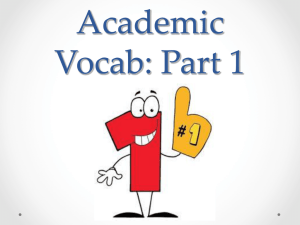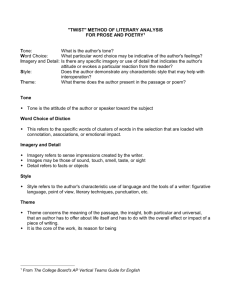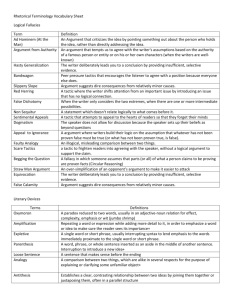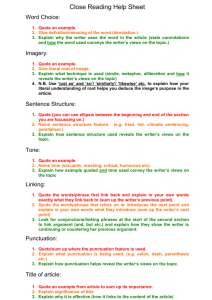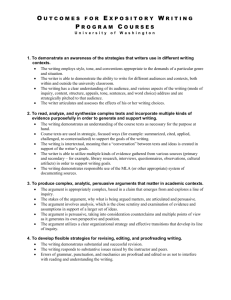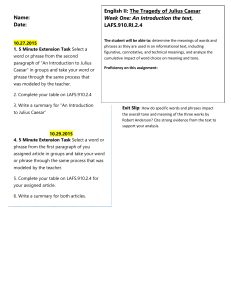summary question
advertisement
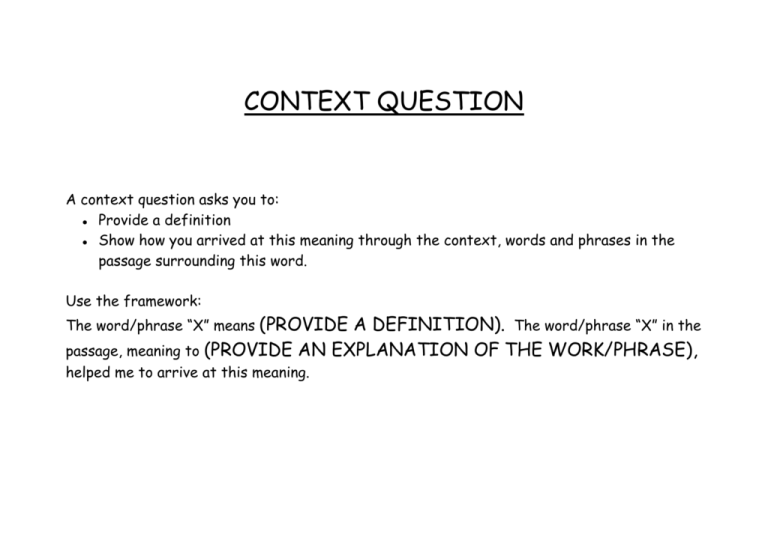
CONTEXT QUESTION A context question asks you to: ● Provide a definition ● Show how you arrived at this meaning through the context, words and phrases in the passage surrounding this word. Use the framework: (PROVIDE A DEFINITION). The word/phrase “X” in the passage, meaning to (PROVIDE AN EXPLANATION OF THE WORK/PHRASE), The word/phrase “X” means helped me to arrive at this meaning. SUMMARY QUESTION ● Summary questions will ask you to find the main points of an argument and put them into your own words. In a summary question, just like a summary paragraph in a Critical Essay, you are taking out the main points and not writing every point in detail. Usually, you will be directed to a fairly large section of the passage. It would be a waste of time and effort to re-write it all in your own words. Underline the main arguments the writer discusses and then put these into your own words. Use bullet-points and tackle a different point for each available mark. ● Remember, you should ● ● ● ● NOT quote! TONE QUESTION REMEMBER THAT A TONE QUESTION WILL NEVER PURLEY ASK YOU TO IDENTIFY TONE LIKE EVALUATION QUESTIONS, YOU WILL NEED TO SHOW HOW YOU ARRIVED AT THE TONE BY COMMENTING ON LANGUAGE TECHNIQUES-IMAGERY, WORD CHOICE, SENTENCE STRUCTURE…. 1. Identify the tone used. Look for words like feelings, attitude, feelings…Remember that at Higher – positive, negative or neutral will not be accepted. Be more specific! ● humorous, light-hearted, chatty, reflective, effusive, nostalgic, sympathetic ● tongue-in-cheek, emotive, persuasive ● caustic, argumentative, serious, sneering, caustic, angry, cynical, 2. Look for language techniques (examples of word choice, sentence structure or imagery). which illustrate this tone. Use the specific approach for each question (word choice, sentence structure or imagery) to show how you arrived at this tone. THE LINK QUESTION Use the Link Framework! Remember that a linking phrase, sentence or even paragraph has a function. It connects arguments/points made in an article. A connection is made between the linking sentence/phrase and the next argument/point being introduced. A connection is made between the linking sentence/phrase and the previous argument/point made. Use the Link Framework: THE WORD/PHRASE “(quote from the link)” REFERS BACK TO THE PREVIOUS TOPIC, NAMELY (define the writer’s first point/argument). THE CONJUCTION “(only quote a linking word or conjunction if it is obvious!) SUGGESTS THAT A NEW ARGUMENT WILL FOLLOW. THE WORD/PHRASE “(quote from the link phrase/sentence) INTRODUCES THE NEW TOPIC, NAMELY (define what the new argument is). WORD CHOICE QUESTION 1. Quote the word or phrase! Be careful – if the question asks for a phrase or expression, you should not quote a SINGLE word! Select the most important words! 2. Provide the denotation (literal meaning) 3. Provide the connotations (associations you have with this word/phrase) 1. Return to the words of the question and explain how your examples of word choice illustrate the writer’s attitude/feelings/tone; a personality trait in a subject; detail concerning a setting or place … SENTENCE STRUCTURE QUESTION Remember that it is NEVER merely enough to identify a type of sentence or punctuation mark. Think about how the use of structure furthers the writer’s argument. When you see a Sentence Structure question – run through your checklist: ● Types of sentence; lengths of sentence; patterning; parallel sentence structure; punctuation … ● Identify the technique (0) ● Explain the function of this technique in the context of the passage. ● Show hoe this particular technique furthers the writer’s argument. Example The writer uses parenthesis to further her criticism of the paranoid society in which se live. She states that parents are “-ably abetted by the Media-“. Here, her parenthesis furthers her argument by adding in her opinion that the Media are also to blame for the molly-coddling of our children. Here, the reference to “abetted” suggests that the Media incite or encourage over-protective parents. IMAGERY QUESTION 1. Quote the image 2. Identity the type of image – metaphor, simile or personification. 3. Provide the literal root of an image. A battery hen is not a relative of the but a hen which is reared in a confined space, producing eggs, and eventually, meat for the retail market. 4. Examine the similarities between the two objects using the framework – “Just as…, so too…” LANGUAGE QUESTION LANGUAGE includes: Word Choice Imagery Structure (sentence structure, punctuation, paragraphing..) Tone Sound Imagery (onomatopoeia, alliteration, assonance) & other aspects of Style – hyperbole, anecdote, puns… APPROACH ● A LANGUAGE question will either give you free range – you will be allowed to select the techniques you wish to tackle. OR it will specify particular techniques you should or must tackle. ● ● ● ● PAY CLOSE ATTENTION TO THE WORDS OF THE QUESTION. Using the WISTS acronym, select the most straightforward technique and tackle this first. Use a sub-heading “WORD CHOICE” and number of bullet-point your analytical points. Move on to the next technique and use the same structure. Remember that in each section – word choice, sentence structure, imagery, tone etc. – you must use the particular approach. Tackle one example for each available mark.
